December 26, 2007
Normally, a mid-year resignation at a mid-major school wouldn’t inspire us to blog about it, but normally, 71-yr old coaches with 798 wins on the resume aren’t taking over mid-majors on an interim basis either.
CBS Sportsline reported today that, after Jessie Evans’ stepdown at the University of San Francisco, Sutton will be taking over as the interim coach of the USF program, effective immediately. USF has gotten off to a moribund 4-8 start this year, losing five of its last six games.
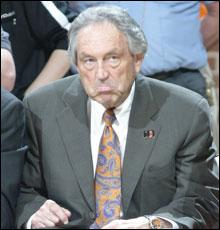
We really can’t figure this one out at all. How did USF even know that Sutton was available? Why is Sutton available? Didn’t he retire from Oklahoma St. two years ago? How effective can a 71-yr old coach with absolutely no ties to a program or region be? Did he already blow through the millions OSU paid him? We’re sitting here scratching our heads.
The only thing we can think is that Sutton is attracted to some of the great do-your-own-thing bars down in the Tenderloin district – the Bambuddha Lounge comes to mind – and with SF being a veritable parking nightmare, the likelihood of yet another embarrassing Sutton DUI is minimal. Or maybe Sutton was wanting for some of the cross-cultural delights that Baghdad by the Bay has to offer? We figure the dude’s totally gonna be rocking leather niprings at next year’s Folsom Street Fair.
Update: Apparently Sutton took the USF job sight-unseen, having never stepped foot on the campus. Sutton stated that he returned because he’s given up drinking and that he wanted to win 800 games before he retired. Evans’ status is one of a leave of absence, with no further information given as to his future at the school.
 Leave a Comment » |
Leave a Comment » |  oklahoma st, san francisco | Tagged: eddie sutton, jessie evans, oklahoma st, san francisco |
oklahoma st, san francisco | Tagged: eddie sutton, jessie evans, oklahoma st, san francisco |  Permalink
Permalink
 Posted by Rush the Court
Posted by Rush the Court
October 4, 2007
Yesterday the NCAA released its latest graduation rate figures for all D1 athletes who entered school in the classes of 1997-2000. Unlike the federally-mandated graduation rate, the GSR (Graduate Success Rate) is more realistic for athletes – it gives each player six years to complete his degree and it does not count transfer students against a school (reflecting the reality of athlete puddle-jumping for playing time in D1).
Here are the NCAA’s key findings:
The latest GSR figures show that 77 percent of student-athletes who began college from 1997-2000 graduated within six years. That four-year graduation rate is unchanged from last year’s data and up from 76 percent two years ago.
The Graduation Success Rate for men’s basketball rose from 55.8 percent in 1995 to 63.6 percent in 2000, a 7.8 percent increase. Football increased from 63.1 percent to 66.6 percent for teams competing in the Bowl Subdivision and from 62 percent to 64.7 percent for teams competing in the Championship Subdivision. Baseball increased from 65.3 percent to 67.3 percent.
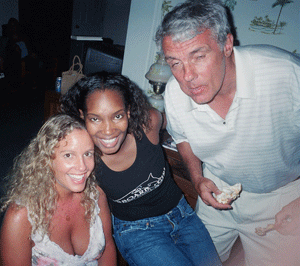
Gary is Too Busy to Worry About Graduation Rates
Since the NCAA doesn’t provide a sortable database of team information (or at least we can’t find it), we decided to quickly throw together some tables showing how the BCS schools performed in this cohort. Gary Williams should be especially proud of himself. Seriously, Gary, the best you can do with those Juan Dixon/Lonny Baxter teams is zero?!? Not even ONE player???
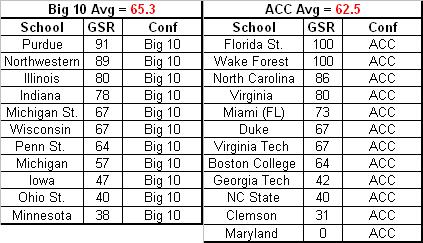
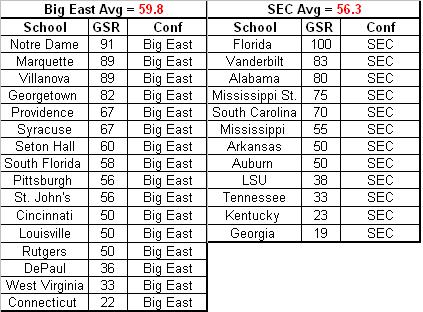
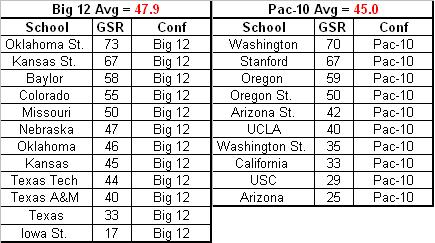
Thoughts.
- At the high end, Florida St. at 100% makes us wonder if any of these stats are credible. Then again, Florida is also at 100%, and these numbers are around 2000, so maybe there was a hanging chad issue or something. We’re also amazed that Eddie Sutton’s band of merry
criminals men led the Big 12.
- At the low end, Jim Calhoun at UConn, Lute Olson at Arizona, Tim Floyd/Larry Eustachy at Iowa St., Ron Jirsa/Jim Harrick at Georgia, and the seediest of all, Clem Haskins at Minnesota, join Gary Williams in the dregs of their respective conferences. What a list of slimy characters there.
- The Pac-10 is surprisingly low, given that Stanford, Cal, UCLA and USC are all great schools. Especially Stanford – how can Mike Montgomery justify graduating only 2/3 of his players? Guess he doesn’t have to at this point – or does he? And the SEC is surprisingly high, with Alabama, the Mississippi schools and South Carolina doing well.
We may have more thoughts on this later, but we’re heading for the airport at the moment, so it’ll have to wait.
 3 Comments |
3 Comments |  florida, florida st, gary williams, georgia, graduation rates, iowa st, jim calhoun, larry eustachy, lute olson, maryland, mike montgomery, minnesota, mississippi st, ncaa, oklahoma st, ole miss, south carolina, stanford | Tagged: acc, alabama, arizona, bcs, big 10, big 12, big east, california, clem haskins, connecticut, eddie sutton, florida, florida st, gary williams, georgia, graduation rates, gsr, iowa st, jim calhoun, jim harrick, larry eustachy, lute olson, maryland, mike montgomery, minnesota, mississippi st, ncaa, oklahoma st, ole miss, pac-10, ron jirsa, sec, south carolina, stanford, tim floyd, ucla, usc |
florida, florida st, gary williams, georgia, graduation rates, iowa st, jim calhoun, larry eustachy, lute olson, maryland, mike montgomery, minnesota, mississippi st, ncaa, oklahoma st, ole miss, south carolina, stanford | Tagged: acc, alabama, arizona, bcs, big 10, big 12, big east, california, clem haskins, connecticut, eddie sutton, florida, florida st, gary williams, georgia, graduation rates, gsr, iowa st, jim calhoun, jim harrick, larry eustachy, lute olson, maryland, mike montgomery, minnesota, mississippi st, ncaa, oklahoma st, ole miss, pac-10, ron jirsa, sec, south carolina, stanford, tim floyd, ucla, usc |  Permalink
Permalink
 Posted by Rush the Court
Posted by Rush the Court
August 12, 2007
Ron Wellman’s decision to elevate Dino Gaudio to the head coaching position at Wake Forest has been universally lauded by the hoopsnascenti over the last couple of days as a great hire. Nobody will dispute that this decision makes sense in terms of continuity for the program, the players and the university. But if you’ll indulge our playing of devil’s advocate for a moment, we ask the question – is this a good hire from a basketball standpoint?
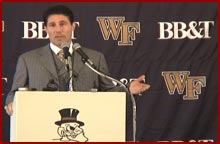
This is a significantly tougher question to address, largely because Gaudio will be evaluated on games yet unplayed. We can point to his unimpressive records at Army and Loyola as evidence of coaching mediocrity; or, we can just as easily dismiss those situations as tantamount to coaching graveyards, where only the truly special of the business can succeed.
So we thought it could be interesting to see how elevating an assistant from within a program tends to work out, historically speaking. We took a look at all the mid- and high-major programs the last three offseasons (2004-06) that elevated an assistant from within its shop to the head coaching position. FYI – there have been six such examples in 2007 – Butler (Brad Stevens), Frank Martin (Kansas St.), Randy Peele (Winthrop), Jeff Reynolds (Air Force), Bob Nash (Hawaii), and Dino Gaudio (Wake Forest).
In 2004, there were four such instances. Three of those new head coaches have gone on to great success at their programs, and the fourth had a solid first year at his before moving on up the ladder the following offseason.
- Mark Fox – Nevada (following Trent Johnson) : rode Nick Fazekas to an 81-18 record the next three seasons, including two NCAA second round appearances. Contrastingly, his predecessor Johnson has largely struggled over on The Farm.
- Doc Sadler – UTEP (following Billy Gillispie) : Sadler continued the Texas Western renaissance for two seasons there, going 48-18 with one NCAA and one NIT appearance.
- Sean Miller – Xavier (following Thad Matta) : Xavier has continued to flourish under Miller, going 63-32 with two NCAA appearances, including the can you top this game vs. Ohio St. in the second round of 2007 that XU should have won.
- Chris Mooney – Air Force (following Joe Scott) : in his only season at AF, he was 18-12 (a slight drop from 22-7 the year prior) before taking a new job at Richmond.

Can Mark Fox continue his Reno Magic w/o Fazekas?
In 2005, there were only two instances. Here too both could be fairly qualified as successful transitions.
- Dave Rose – BYU (following Steve Cleveland) : in two seasons, Rose has taken the Cougs to one NCAA appearance and one NIT appearance, going 45-18 over that period.
- Andy Kennedy – Cincinnati (following Bob Huggins) : Kennedy enjoyed a 21-13 season in his only at the helm after Thuggins was fired, but what’s most telling is the utter collapse in the season after Kennedy was released by UC. The Bearcats were an atrocious 11-19 overall and dead last in the Big East (2-14) in 2006-07. Great decision there.
Last offseason there were four instances, and in a weird coincidence, two of those assistants were coach’s sons who had been formally groomed to take over the program. In one case, the new coach far exceeded his predecessor; in the others, it was largely status quo.
- Sean Sutton – Oklahoma St. (following Eddie Sutton) : Sean’s first year at the helm for the Pokes was up-and-down. OSU started strong, winning 16 of its first 17 games, but limped into the finish with an overall record of 22-13 (6-10) and losing in the first round of the NIT at home. This was still an improvement over his dad’s final season (17-16) (6-10), however.
- Tony Bennett – Washington St. (following Dick Bennett) : this was the feel-good story of the year, as son Tony updated his dad’s offense and took the Pac-10 and nation by surprise, going 26-8 (13-5) – a fifteen win improvement – and making the program’s first NCAA tournament since 1994.
- Ben Jacobson – Northern Iowa (following Greg McDermott) : this very solid mid-major program had its first non-NCAA appearance in four years during Jacobson’s first season at the helm, as his team sputtered to a pedestrian 18-13 campaign in the very competitive MVC.
- Fred Hill – Rutgers (following Gary Waters) : Hill’s first season is one he’d like to forget, we’re sure. The Scarlet Knights were 10-19 (3-13) and battled with Cincinnati for the distinction as worst team in the Big East all season long. Waters’ final season ended at 19-10, which was a cause for celebration with Rutgers basketball.

Tony Bennett is the Model for Gaudio
Obviously, it’s tough to draw a persuasive conclusion from this sample size, and we also realize that every situation involves different factors. Nevertheless, we find it striking that in seven of the ten instances above, the assistant coach who was elevated either outperformed his predecessor or kept the program at the level of success it already enjoyed (or not enjoyed, as with Oklahoma St.). In two cases, there was a slight dropoff from previous levels, and in only one case of a single season sample there was a significant decrease.
The problem with analyzing Gaudio’s situation at Wake in this light is that status quo means that he’ll be regularly finishing in the cellar of the ACC. With the recruits he has arriving one year from now, he’ll be expected to significantly outperform what Prosser accomplished during the last two seasons. Put another way, Deacon faithful will be satisfied with nothing less than challenging for the ACC title and annual NCAA appearances – much like the first four years of Prosser’s tenure. This is a high bar, but if the recent history of Gaudio’s peers is any indication, he may have a great shot at clearing it.
 1 Comment |
1 Comment |  dino gaudio, doc sadler, hawaii, jeff reynolds, kansas st, loyola (md), mark fox, northern iowa, oklahoma st, randy peele, rutgers, sean miller, tony bennett, utep, wake forest, washington st, xavier | Tagged: acc, air force, andy kennedy, army, assistant coach, ben jacobson, bob hill, bob huggins, bob nash, brad stevens, butler, byu, chris mooney, cincinnati, dave rose, dick bennett, dino gaudio, doc sadler, eddie sutton, frank martin, hawaii, jeff reynolds, kansas st, loyola (md), mark fox, nevada, nick fazekas, northern iowa, ohio st, oklahoma st, randy peele, rutgers, sean miller, sean sutton, tony bennett, utep, wake forest, washington st, winthrop, xavier |
dino gaudio, doc sadler, hawaii, jeff reynolds, kansas st, loyola (md), mark fox, northern iowa, oklahoma st, randy peele, rutgers, sean miller, tony bennett, utep, wake forest, washington st, xavier | Tagged: acc, air force, andy kennedy, army, assistant coach, ben jacobson, bob hill, bob huggins, bob nash, brad stevens, butler, byu, chris mooney, cincinnati, dave rose, dick bennett, dino gaudio, doc sadler, eddie sutton, frank martin, hawaii, jeff reynolds, kansas st, loyola (md), mark fox, nevada, nick fazekas, northern iowa, ohio st, oklahoma st, randy peele, rutgers, sean miller, sean sutton, tony bennett, utep, wake forest, washington st, winthrop, xavier |  Permalink
Permalink
 Posted by Rush the Court
Posted by Rush the Court
April 27, 2007
Apparently Gary Parrish hit a sore spot with many SEC fans based on the reaction he received to his article on CBS Sportsline earlier this week. As we stated in our response to his article, not all of the criticism he received is without merit.
Parrish wrote a follow-up article today, which in our opinion, states the essential point that he should have made in the first incarnation. Namely, although it is unfortunate and a bit peculiar that three black coaches left SEC schools (whether willingly or unwillingly) in the past two years, it is not due to racism per se that these coaches are no longer with their schools. In other words, it is not their blackness alone that got these coaches in trouble, for these and other SEC schools have had successful black coaches in the past; it is their blackness in combination with a prevailing perception of not meeting the high expectations of the fans as head coach. As he put it simply, “minority coaches operate on a shorter leash.”
 OR
OR  ??
??
There is merit to this argument, and we wish Parrish had made it more clearly in the first article. There are valid concerns as to why a coaching clown like John Brady at LSU can continue with legitimate employment after ten years of mostly disappointing seasons. Or how a squirrelly little man such as Dave Odom can continue cashing SC’s checks after one NCAA appearance in six years (unless your goal as an SEC program is to win NIT championships, as he’s very accomplished at that). We have absolutely no doubt that black coaches at these schools would have been gone long before these gents. As we noted in our initial response, we’re still not past the point where “diversity” in the SEC amounts to much more than blondes and redheads. However, it must be stated that a very successful black coach at any SEC school – in football or basketball – would be warmly embraced by its fans despite the racial component.
 OR
OR  ??
??
As a final point, let’s also throw out another possible confounding factor in the cases of Tubby Smith and Stan Heath. We’ll leave Rod Barnes out of this discussion, because even Parrish concedes that his record at Ole Miss was lacking. Could part of the reason that Smith and Heath felt so much heat in comparison to coaches like Brady, Gottfried and Odom has something to do with how basketball is treated at those particular schools, rather than attributing all of it to race? Everyone knows that the expectations at UK are through the roof every season. Arkansas, while at heart a football school, could also fairly be described as a basketball school as well. Their fans have supported the hardwood Hawgs dating back to Eddie Sutton’s days there in the 1970s, and they’ve been to multiple Final Fours and won a championship in 1994.
Contrast that with LSU, Alabama and South Carolina, where football is absolutely and undoubtedly king. Basketball is by most fans still considered a stepbrother to the gridiron – sure, the fans want to see the program do “well,” but well is defined in the context of making the NCAAs fairly often, and maybe winning a game or two the years you get there. Those kinds of expectations get football coaches like Dennis Franchione , Gerry DiNardo and Mike Shula fired quickly (and they’re all white!). The level of expectations for basketball at these schools are far from what you see at UK, Arkansas, and as of now, Florida in the SEC. Perhaps this issue trumps all else when it comes to dealing with fan expectations at these particular schools.
 1 Comment |
1 Comment |  florida, gary parrish, john brady, lsu, ole miss, racism, rod barnes, south carolina, tubby smith | Tagged: alabama, arkansas, black coaches, dave odom, eddie sutton, florida, gary parrish, john brady, kentucky, lsu, ole miss, racism, rod barnes, sec, south carolina, stan heath, tubby smith |
florida, gary parrish, john brady, lsu, ole miss, racism, rod barnes, south carolina, tubby smith | Tagged: alabama, arkansas, black coaches, dave odom, eddie sutton, florida, gary parrish, john brady, kentucky, lsu, ole miss, racism, rod barnes, sec, south carolina, stan heath, tubby smith |  Permalink
Permalink
 Posted by Rush the Court
Posted by Rush the Court




 Posted by Rush the Court
Posted by Rush the Court 


 OR
OR  ??
?? OR
OR  ??
??